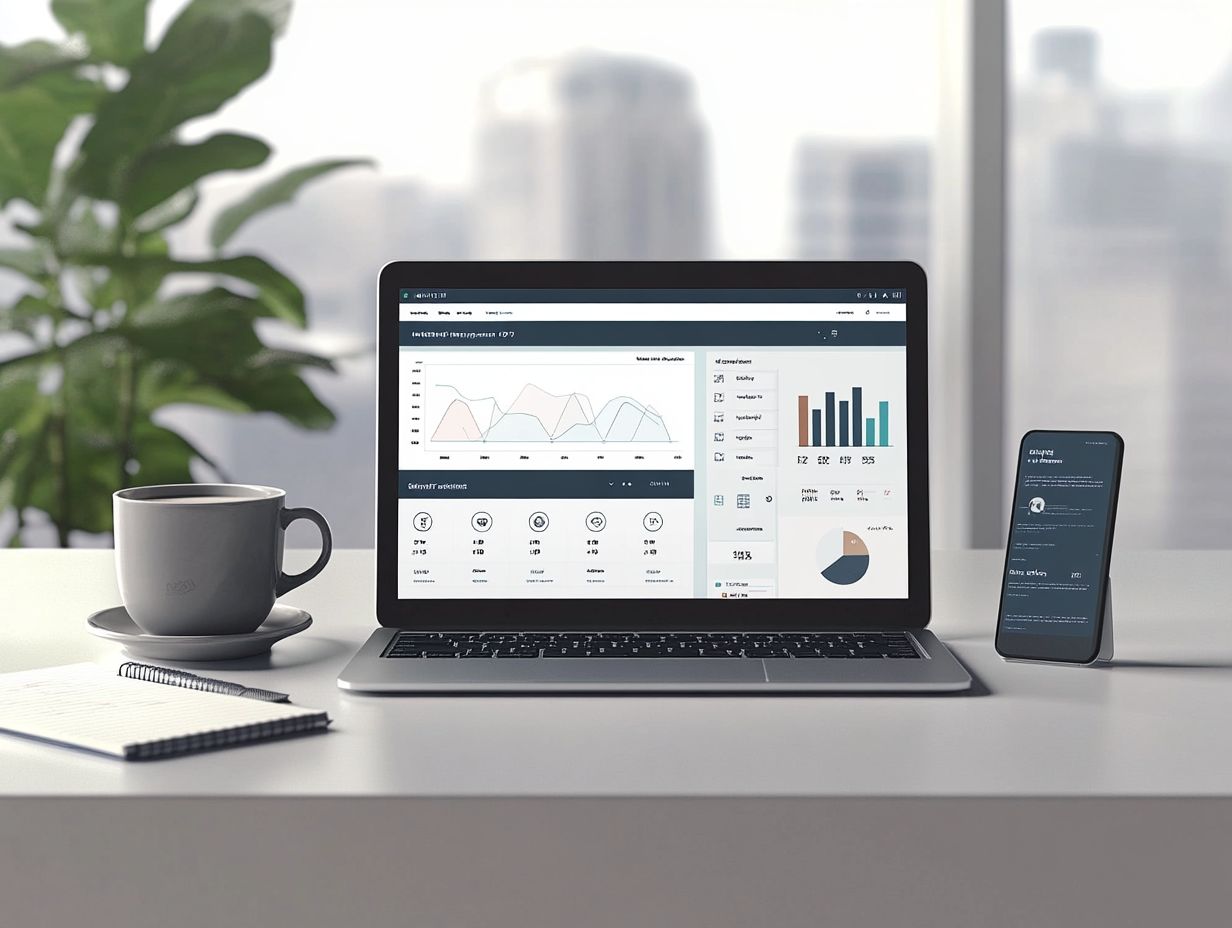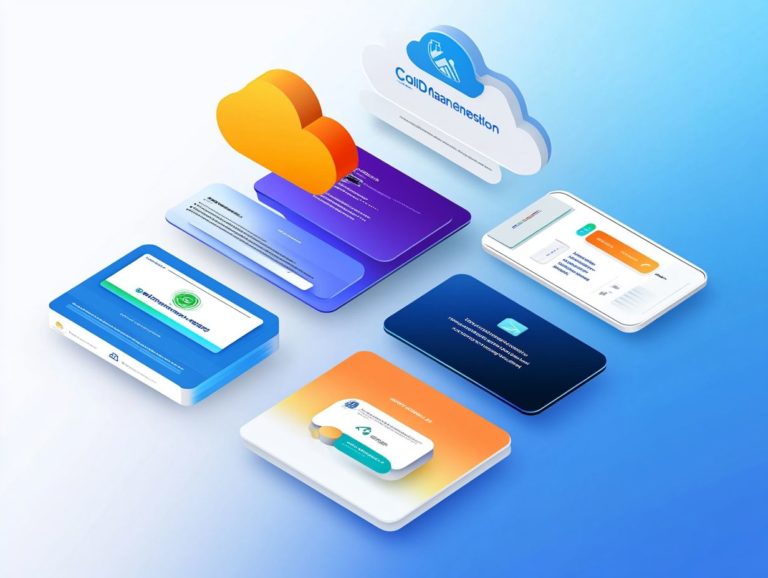10 Insights on Cloud Cost Management
In today’s digital landscape, managing cloud costs is a critical concern for businesses of all sizes, and you aren’t exempt from its challenges. With various types of cloud expenses ranging from infrastructure to operational costs understanding and optimizing these financial elements is essential for maintaining your organization’s fiscal health and operational efficiency.
This article delves into ten key insights into cloud cost management, emphasizing the importance of tracking expenses, the consequences of unused resources, and effective strategies for negotiating with providers. You’ll discover how to strike the perfect balance between performance and cost efficiency. Learn how to save money today!
Whether you’re grappling with common challenges or strategizing for future expenses, this guide gives you practical steps you can take right now to ensure that your cloud investments are not only effective but also economical.
Contents
- Key Takeaways:
- 1. Understanding the Different Types of Cloud Costs
- 2. The Importance of Tracking and Monitoring Cloud Costs
- 3. Utilizing Cost Allocation and Tagging
- 4. The Impact of Unused Resources on Cloud Costs
- 5. The Role of Automation in Cost Management
- 6. Balancing Performance and Cost Optimization
- 7. Strategies for Negotiating with Cloud Providers
- 8. The Risks of Overspending on Cloud Services
- 9. The Benefits of Cloud Cost Optimization Tools
- 10. The Importance of Regularly Reviewing and Adjusting Cloud Costs
- What Are the Key Factors to Consider When Managing Cloud Costs?
- How Can a Business Determine the Best Cloud Cost Management Strategy for Them?
- What Are the Common Challenges in Cloud Cost Management?
- How Can a Business Plan for Future Cloud Cost Changes?
- What Are the Potential Savings of Effective Cloud Cost Management?
- How Can a Business Ensure Security and Compliance While Managing Cloud Costs?
- Frequently Asked Questions
- What are the key factors to consider when managing cloud costs?
- How can a company ensure cost efficiency in their cloud services?
- What are some common challenges faced in managing cloud costs?
- How can a company determine the best cloud pricing model for their needs?
- What are some best practices for monitoring and optimizing cloud costs?
- How does cloud cost management contribute to overall cost savings for a company?
Key Takeaways:

- Understand and manage different types of cloud costs effectively.
- Tracking and monitoring cloud costs is crucial for controlling and optimizing cloud spending.
- Utilizing cost allocation and tagging can help identify and allocate costs to specific projects or departments, providing transparency and control over cloud spending.
1. Understanding the Different Types of Cloud Costs
Understanding the various types of cloud costs is essential for your business as you start using cloud services. These costs can differ significantly across platforms like AWS, Azure, and Google Cloud, affecting your costs and budgeting.
Operational costs include factors such as data storage fees, computing power, and network usage, all of which can vary based on your usage patterns. You might encounter fixed costs, like subscription fees or reserved instances, alongside variable costs that typically arise from pay-as-you-go models.
Each cloud provider has its own unique pricing structure, making it crucial for you to carefully analyze your specific needs.
If you’re considering a hybrid cloud setup that incorporates both public and private infrastructures, be prepared for added complexities in cost management. This often necessitates detailed financial assessments to optimize your investment while maximizing scalability and efficiency.
2. The Importance of Tracking and Monitoring Cloud Costs
Tracking and monitoring cloud costs is essential for effective management, as it provides you with visibility into cost drivers and gives you the power to implement cost control measures promptly.
By leveraging advanced cost monitoring tools and cloud governance toolkits, you can gain invaluable insights into your spending patterns. These tools showcase trends and anomalies in expense reports and play a critical role in proactive cost management.
With features like anomaly detection, you can quickly spot unexpected expenses that might jeopardize your budget stability.
Armed with these capabilities, you can swiftly address any irregularities, ensuring that resources are allocated efficiently and overspending is kept at bay. This ultimately enhances your overall financial health.
3. Utilizing Cost Allocation and Tagging
Utilizing cost allocation and tagging strategies is crucial for effectively understanding and managing your cloud expenses. These strategies empower your teams to closely monitor resource usage, making it simpler to identify areas ripe for potential savings.
For example, employing tags like project names, departments, or environments helps you distinguish costs across shared setups, such as multi-tenant architectures. This ensures that your teams can accurately assess and optimize their cloud spending.
In dedicated environments, tagging can further enhance your budgeting processes by grouping expenses related to specific applications or services. This tailored approach boosts transparency and streamlines the identification of financial responsibility across different units, ultimately supporting more well-considered choices.
4. The Impact of Unused Resources on Cloud Costs
Unused resources can significantly inflate your cloud costs, making it vital to adopt effective cost strategies like the benefits of cloud cost management.
Conduct regular audits to gain insights into your resource use. Pinpoint areas where money is wasted. It s crucial to assess these resources systematically. Even a small percentage of unused capacity can lead to a substantial financial drain over time.
To tackle this challenge, consider actionable strategies such as employing automation tools to streamline your monitoring processes. Establish policies for automatic scaling. This approach will supercharge your resource management!
Repurpose underused assets for other projects to maximize their value. This ultimately drives down operational costs while enhancing your overall productivity.
5. The Role of Automation in Cost Management
Automation is a game-changer in managing cloud costs. It allows you to employ automated cost optimization techniques that harness the power of machine learning for efficient resource provisioning.
Tools like CloudHealth and AWS Cost Explorer utilize machine learning algorithms. They analyze usage patterns and predict future costs. These platforms pinpoint discrepancies in spending and provide actionable recommendations to address inefficiencies.
By automating the monitoring process, you can effortlessly keep tabs on your cloud expenses. Ensure you stay within budget while optimizing overall resource allocation. This approach enhances your financial decision-making in a landscape that s becoming increasingly digital.
6. Balancing Performance and Cost Optimization

Balancing performance with cost optimization is a significant challenge. You strive to achieve operational benefits while effectively managing your cloud expenses through multi-cloud strategies.
Every dollar matters, and efficiency is key. Implement optimization techniques like right-sizing instances and adopting containerization to enhance performance without inflating costs.
A multi-cloud strategy grants you the flexibility to tailor your infrastructure. This enables you to tap into the best services from different providers according to your specific needs. This approach maximizes resource utilization and mitigates the risks associated with vendor lock-in, providing you with a broader perspective on operational resilience.
7. Strategies for Negotiating with Cloud Providers
Negotiating with cloud providers is key to getting better pricing. Effective negotiation secures favorable pricing discounts and ensures that the services align with your organization s compliance standards.
Analyze their pricing models thoroughly. Understanding the complexities of various service tiers can reveal cost reduction areas. Present a strong value proposition that clearly outlines your specific operational requirements to fortify your negotiation position.
It s essential to approach these discussions with transparency about your long-term goals and usage patterns. This openness fosters trust and encourages providers to propose tailored solutions that align with your strategic objectives. Adopting this collaborative mindset can pave the way for mutually beneficial agreements.
Start auditing your resources today to uncover hidden savings!
8. The Risks of Overspending on Cloud Services
Overspending on cloud services can seriously jeopardize your organization s financial governance. Effective budget forecasting is crucial to mitigate risks associated with unpredictable cloud expenses.
When you face budget overruns, it disrupts cash flow and undermines your strategic goals. The resulting financial strain may limit the resources available for innovation and expansion, ultimately affecting your competitiveness in the market.
You must adopt strong budgeting practices now to avoid pitfalls! By establishing clear budgets and implementing robust tracking systems, you can gain better visibility into your cloud expenditures.
This proactive approach gives you the power to make informed decisions and adjust allocations as needed, ensuring greater financial stability and fostering long-term growth for your organization.
9. The Benefits of Cloud Cost Optimization Tools
Cloud cost optimization tools like CloudHealth, Flexera, and Apptio offer you invaluable insights and operational advantages. To enhance your strategy further, consider implementing best practices for managing cloud costs that enable you to monitor and manage your cloud expenses efficiently.
These platforms give you the power to analyze your cloud usage patterns, allowing for informed adjustments that enhance your budget management. By leveraging advanced analytics, they help you identify underutilized resources and excessive spending.
These tools are crucial for making decisions based on data, transforming complex data into actionable insights. Beyond the financial benefits, integrating cloud cost optimization tools also supports your sustainability goals by promoting a more eco-friendly approach to cloud computing.
10. The Importance of Regularly Reviewing and Adjusting Cloud Costs
Regularly reviewing and adjusting your cloud costs is essential for ensuring compliance with financial governance. It also helps you manage your budget forecasting in today s ever-evolving cloud landscape.
These periodic reviews act as crucial checkpoints to confirm that your cloud expenditures align with your current financial strategy and support your broader business objectives.
By examining metrics such as usage patterns, cost per user, and resource allocation, you can identify inefficiencies or areas ripe for savings. Analyzing these data points gives you the power to make informed adjustments that enhance how well you run your operations.
This ongoing process lets you quickly adapt to new challenges, ensuring that your cloud investments positively impact your bottom line and strategic direction.
What Are the Key Factors to Consider When Managing Cloud Costs?
When managing cloud costs, you need to consider key factors such as operational expenses, the implementation of cloud governance toolkits, and effective cost control measures. This helps uphold financial governance.
A structured approach is essential for utilizing resources more efficiently and avoiding those dreaded surprise expenditures. This means establishing robust governance frameworks that clearly define roles and responsibilities.
Along with detailed monitoring mechanisms, you can track usage and spending in real-time. Regular audits and reviews of cloud services help you find inefficiencies and save resources.
By promoting a culture of accountability, you empower your teams to manage costs effectively, ensuring that your cloud investments align seamlessly with your overall financial objectives.
How Can a Business Determine the Best Cloud Cost Management Strategy for Them?

Determining the ideal cloud cost management strategy for your business hinges on data-driven decision-making. It’s essential to pinpoint effective tips to reduce cloud costs that align with your specific operational needs.
This means thoroughly assessing your current resource usage, forecasting future requirements, and identifying opportunities to optimize cloud resources. A comprehensive approach ensures that financial considerations become integral to your planning process rather than an afterthought.
Take, for instance, a medium-sized company that successfully deployed a cloud monitoring tool to analyze usage patterns. This allowed them to adjust their subscriptions based on actual needs rather than mere projections. The result? A remarkable 20% reduction in costs, showcasing the importance of understanding the future of cloud cost management!
This example illustrates that when cost management strategies align with overall business goals, significant savings can be achieved while simultaneously boosting operational efficiency.
What Are the Common Challenges in Cloud Cost Management?
Understanding the challenges in cloud cost management is crucial for success. Common obstacles include following rules and regulations, ensuring financial governance, and managing the complexities of multi-cloud environments, especially as highlighted in the 5 key takeaways for cloud cost management success.
You may often find yourself grappling with unexpected expenses arising from excess resources, where redundant or under-utilized services contribute to inflated bills.
The changing cloud pricing can complicate your budgeting efforts, making it challenging to predict long-term costs accurately.
To tackle these issues, consider integrating robust cloud cost management tools that provide you with greater visibility into spending trends and resource usage. Additionally, exploring 5 ways to improve cloud cost transparency can enhance your approach. Implementing regular audits and establishing clear budgeting practices can help you maintain financial control.
Fostering a culture of cost awareness among your technical teams is essential. By empowering everyone to make informed decisions, you align their actions with the organization s financial goals.
How Can a Business Plan for Future Cloud Cost Changes?
A well-structured plan for future cloud cost changes is essential for effectively managing operational costs. This ensures accurate budget forecasting in a dynamic environment.
To navigate the complexities of cloud expenses, it s crucial for your organization to assess specific usage trends. Consider factors like anticipated growth in user demand and the introduction of new services.
Staying informed about market trends and industry shifts will help you predict potential price fluctuations. By proactively analyzing these elements, you can create a financial roadmap that seamlessly adapts to changes in cloud pricing. Don t wait until costs spiral out of control! Act now to improve your cloud cost management.
Ultimately, this strategy builds financial strength, empowering you to allocate resources judiciously and optimize your cloud investments.
What Are the Potential Savings of Effective Cloud Cost Management?
Effective cloud cost management can lead to significant savings for you! It allows your organization to implement 5 strategies for reducing cloud costs and execute actions that enhance financial performance.
By leveraging a combination of strategies such as resource tagging, automated scaling, and usage monitoring, you can uncover hidden inefficiencies that, once addressed, can lead to substantial reductions in expenditure.
For example, a documented case study from a leading tech company showed that by optimizing their cloud resources, they achieved a remarkable 30% decrease in costs within a single quarter.
Success metrics like reduced monthly billing and improved utilization rates highlight that smart financial planning, coupled with proactive resource management, can not only strengthen your bottom line but also create opportunities for reinvestment in innovation and growth.
How Can a Business Ensure Security and Compliance While Managing Cloud Costs?
It’s crucial for your business to ensure security and compliance while effectively managing cloud costs today! This not only upholds essential standards but also strengthens your financial governance.
By adopting a proactive approach, you can leverage various strategies that seamlessly blend security measures with cost management practices. This might involve using tools that provide a comprehensive dashboard, allowing you to visualize spending alongside compliance alerts. This fosters a cohesive understanding of both your financial and security health.
Use automation tools to monitor your cloud resources. This helps to mitigate overspending while ensuring consistent enforcement of your security policies.
Regular audits and assessments using specialized software can reveal vulnerabilities and inefficiencies, empowering you to make informed decisions on resource allocation without compromising compliance.
Frequently Asked Questions
What are the key factors to consider when managing cloud costs?

The key factors to consider when managing cloud costs include having a clear understanding of your cloud usage and needs, regularly monitoring and optimizing your cloud resources, setting budgets and cost limits, and exploring 5 ways to enhance cloud cost visibility with cost management tools and services.
How can a company ensure cost efficiency in their cloud services?
A company can ensure cost efficiency in their cloud services by regularly analyzing and optimizing their cloud usage, using cost-effective cloud services, automating cost management processes, and leveraging discounts and savings programs offered by cloud providers.
What are some common challenges faced in managing cloud costs?
Some common challenges faced in managing cloud costs include limited visibility into cloud usage and costs, difficulty in forecasting and budgeting, unexpected costs and overages, and a lack of understanding or expertise in cloud cost management.
How can a company determine the best cloud pricing model for their needs?
A company can determine the best cloud pricing model for their needs by considering factors such as their workload requirements, budget, and cost predictability. They can also consult with their cloud service provider and use cost calculators to compare and estimate costs across different pricing models.
What are some best practices for monitoring and optimizing cloud costs?
Best practices for monitoring and optimizing cloud costs include setting and regularly reviewing budgets and cost limits, using cost management tools and services, right-sizing resources, utilizing reserved instances (prepaid resources for cost savings) or savings plans, and regularly analyzing and optimizing your cloud usage.
How does cloud cost management contribute to overall cost savings for a company?
Effective cloud cost management can contribute to overall cost savings for a company by helping them reduce unnecessary cloud spending, optimize resource usage, and negotiate favorable pricing with their cloud service provider. For businesses looking to enhance their strategies, exploring the 5 best cloud cost management strategies for 2024 can also allow them to budget and plan more accurately, leading to cost predictability and better financial management.






